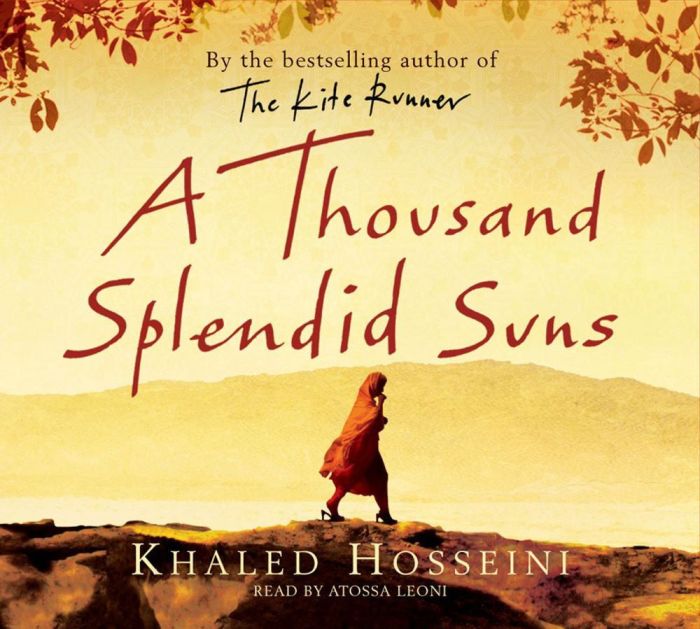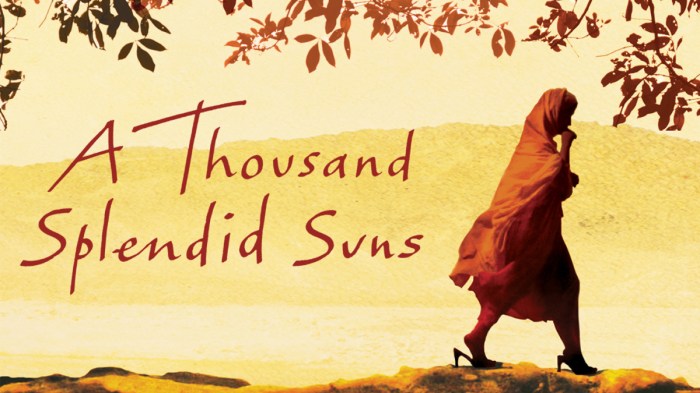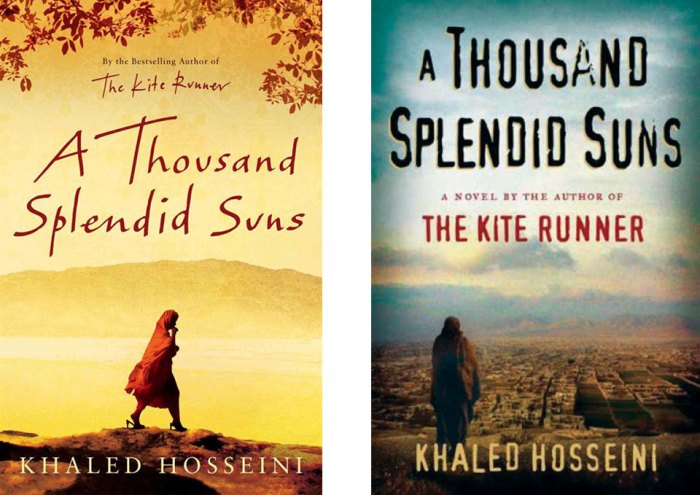Symbols of a Thousand Splendid Suns, a poignant and thought-provoking novel by Khaled Hosseini, weaves a tapestry of hope, oppression, and resilience amidst the turbulent landscape of Afghanistan. This literary masterpiece explores the profound impact of cultural symbols on individuals and society, delving into the complexities of Afghan tradition, female subjugation, and the indomitable spirit of human connection.
Symbols in “A Thousand Splendid Suns”

Khaled Hosseini’s “A Thousand Splendid Suns” is a powerful novel that explores the lives of two Afghan women, Mariam and Laila, against the backdrop of war and oppression. The novel is rich in symbolism, with various objects and elements representing deeper themes and ideas.
The Pomegranate as a Symbol of Hope and Renewal
The pomegranate is a recurring symbol throughout the novel, representing hope and the possibility of renewal. Mariam’s mother, Nana, is described as having a pomegranate birthmark on her cheek, symbolizing her resilience and the hope she carries despite her tragic life.
The pomegranate also appears in the form of a tree in Mariam’s childhood home, offering a sense of safety and comfort amidst the chaos.
The Burqa as a Symbol of Oppression and Female Subjugation
The burqa, a full-body covering worn by Afghan women, is a potent symbol of oppression and female subjugation. It represents the Taliban’s strict interpretation of Islamic law, which restricts women’s freedom and autonomy. Laila and Mariam both experience the suffocating effects of the burqa, which becomes a physical manifestation of their suppressed identities.
The Wind as a Representation of Change and Freedom
The wind is a powerful force in the novel, representing change and freedom. It is associated with moments of liberation and escape, such as when Laila and Tariq run away together. The wind also symbolizes the cyclical nature of life, as it brings both destruction and renewal, just as the war brings both suffering and hope.
Character Symbolism in “A Thousand Splendid Suns”
Mariam as the Symbol of Resilience
Mariam embodies the indomitable spirit of women who endure adversity. Despite facing rejection, abuse, and societal isolation, she demonstrates resilience and strength. Her ability to find solace in nature and her unwavering determination to survive are testaments to the resilience of the human spirit in the face of adversity.
Laila as the Symbol of Education and Self-Determination
Laila represents the transformative power of education and self-determination. Through her pursuit of knowledge and her defiance of societal norms, she empowers herself and challenges traditional gender roles. Laila’s journey symbolizes the potential for Afghan women to break free from oppression and achieve self-fulfillment.
Tariq and Zalmai as Representations of Different Paths for Afghan Men
Tariq and Zalmai are contrasting symbols of the different paths available to Afghan men. Tariq represents the traditional, patriarchal path of violence and domination, while Zalmai embodies a more progressive and compassionate approach. Their characters highlight the choices and responsibilities that Afghan men face in a society grappling with modernization and change.
Cultural Symbolism in “A Thousand Splendid Suns”: Symbols Of A Thousand Splendid Suns
Khaled Hosseini’s “A Thousand Splendid Suns” is a novel rich in cultural symbolism, drawing upon traditional Afghan folklore and mythology to convey complex themes and explore the clash between traditional Afghan culture and Western influences.
The Significance of Namus, Symbols of a thousand splendid suns
Namus, a central concept in Afghan culture, is the idea of honor and reputation, particularly as it pertains to women. The novel portrays the devastating impact of namus on the lives of Mariam and Laila, who are both victims of violence and oppression due to their perceived transgressions against societal norms.
Mariam’s status as a harami, an illegitimate child, brings shame upon her family, leading to her isolation and abuse. Laila, despite her intelligence and independence, is forced to marry a cruel man to protect her family’s honor after her fiancé is killed.
The novel exposes the suffocating and oppressive nature of namus, which perpetuates gender inequality and limits women’s freedom.
The Clash of Cultures
The novel also depicts the clash between traditional Afghan culture and Western influences, particularly through the character of Tariq, Laila’s son. Tariq embodies the values of modernity and individualism, which are in direct contrast to the collectivist and honor-based traditions of his society.
Tariq’s Western education and his relationship with Laila challenge societal norms and provoke conflict with his family. The novel suggests that while Western influences can bring progress and liberation, they can also create tension and disruption within traditional communities.
Symbolism in the Setting of “A Thousand Splendid Suns”

The setting of “A Thousand Splendid Suns” plays a pivotal role in shaping the narrative and conveying the novel’s themes. The city of Kabul, the physical landscape of Afghanistan, and the recurring images of war and destruction serve as powerful symbols that reflect the characters’ experiences and the tumultuous history of the country.
Kabul as a Microcosm of Afghan Society
Kabul, the capital of Afghanistan, is depicted as a microcosm of Afghan society. It is a city of contrasts, where modern skyscrapers stand alongside ancient ruins, and where wealth and poverty coexist in close proximity. The city’s chaotic and often violent streets reflect the political and social turmoil that has plagued Afghanistan for decades.
The Physical Landscape of Afghanistan
The physical landscape of Afghanistan is used to reflect the characters’ emotional and psychological states. The harsh and unforgiving terrain mirrors the characters’ own struggles and resilience. The mountains represent both the beauty and the danger of the country, while the deserts symbolize the isolation and loneliness that the characters experience.
Symbolism of War and Destruction
The recurring images of war and destruction in the novel serve as a constant reminder of the devastating impact of conflict on the lives of the characters. The bombed-out buildings, the refugee camps, and the presence of landmines all speak to the horrors of war and its lasting effects on the people of Afghanistan.
Visual Representation of Symbols in “A Thousand Splendid Suns”

The novel and film adaptation of “A Thousand Splendid Suns” employ distinct visual representations to convey the profound symbolism woven into the narrative. This comparative analysis examines the contrasting visual interpretations of key symbols, highlighting the unique strengths and nuances of each medium.
Table: Visual Representation of Symbols in Novel and Film
The following table compares the visual representation of symbols in the novel and film adaptation:
| Symbol | Novel | Film |
|---|---|---|
| Pomegranate | A symbol of fertility, life, and the beauty of Afghanistan | Visually depicted through close-up shots of the fruit’s vibrant seeds |
| Burqa | A symbol of oppression and the subjugation of women | Rendered through long, flowing fabric obscuring the faces of women |
| Kabul | A symbol of both the beauty and the tragedy of Afghanistan | Visually portrayed through aerial shots of the city’s bustling streets and bombed-out ruins |
| Kite | A symbol of freedom and the indomitable spirit of the Afghan people | Depicted through sweeping shots of kites soaring high in the sky |
| Minaret | A symbol of resilience and hope amidst adversity | Visually represented through shots of the tall, slender towers standing amidst the chaos of war |
Illustrations and Symbolic Significance
To further explore the visual representation of symbols, the following illustrations depict key symbols from the novel and provide detailed descriptions of their significance:
-
Pomegranate:A vibrant illustration of a pomegranate, its seeds spilling forth, symbolizes the promise of life and the beauty that can emerge from adversity.
-
Burqa:A haunting image of a woman enveloped in a flowing burqa, her face obscured, representing the suffocating oppression faced by Afghan women.
-
Kabul:A panoramic view of Kabul, its skyline a mix of modern skyscrapers and ancient ruins, capturing the city’s complex history and the juxtaposition of beauty and devastation.
-
Kite:A colorful kite soaring high in the sky, its tail streaming behind it, symbolizing the indomitable spirit and resilience of the Afghan people.
-
Minaret:A towering minaret, its intricate carvings reaching towards the heavens, representing the strength and resilience of the Afghan people amidst adversity.
Vivid Imagery and Symbolic Meaning
The novel’s vivid imagery effectively conveys symbolic meanings through descriptive language. The following passages illustrate the power of visual representation in conveying the novel’s themes:
“The pomegranate seeds spilled onto the carpet like rubies, each one a promise of life and beauty.”
“The burqa was like a prison, suffocating her, hiding her from the world.”
“Kabul was a city of contrasts, a kaleidoscope of beauty and devastation.”
“The kite soared high in the sky, a symbol of hope and freedom.”
“The minaret stood tall, a beacon of resilience in the midst of the chaos.”
Through these visual representations and vivid imagery, both the novel and film adaptation of “A Thousand Splendid Suns” effectively convey the profound symbolism that permeates the narrative, enhancing the emotional impact of the story and its exploration of themes related to oppression, resilience, and the enduring human spirit.
Common Queries
What is the significance of the pomegranate in the novel?
The pomegranate symbolizes hope and renewal, representing the characters’ resilience and longing for a better future.
How does the burqa represent female subjugation?
The burqa is a powerful symbol of the oppression and control faced by women in Afghanistan, restricting their freedom and identity.
What does the wind symbolize in the novel?
The wind represents change and freedom, carrying both hope and uncertainty as the characters navigate the tumultuous events of their lives.
